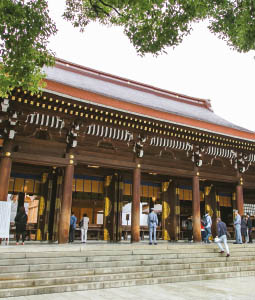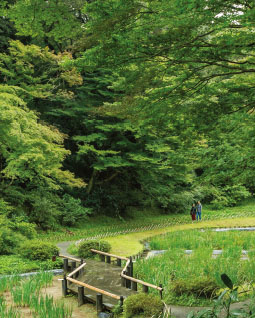Home > Highlighting JAPAN > Highlighting Japan November 2018 > Living In Tune with Nature: Japan's Connection to Wood
Highlighting JAPAN


People and NatureTransform a Wasteland into a Special Forest
A vast forest surrounds Meiji Jingu Shrine close by Tokyo’s bustling Harajuku Station. It took a hundred years, the wisdom of people and power of nature to transform this former wasteland into a flourishing forest. Meiji Jingu representatives spoke about the superb plan for this transformation drawn up in the 1910s and their own measures.
In Japan, diverse kami (divine spirits) have arisen from people’s reverence for various natural phenomena, living creatures and individuals. Since ancient times, forests have been deeply tied to these spirits. The country’s shrines honor those kami, and the groves surrounding them are known as chinju no mori, or sacred forests.
The 700,000-square-meter woodland that sprawls next to Harajuku Station is a sacred forest that encompasses Meiji Jingu, dedicated to Emperor Meiji and the Empress Shoken. The shrine was completed in 1920, and the trees enfolding it were planted around the same time.
According to Miki Fukutoku, chief of Meiji Jingu’s public relations department, the site was once mostly wasteland. When the shrine asked for donations of trees to plant there, 100,000 were shipped from all over Japan and neighboring countries, and 110,000 volunteers helped to plant them.
“The characteristics of Meiji Jingu’s forest are that it consists mainly of evergreen broadleaf trees that match the local soil and climate, and that it was planned to become an ‘eternal forest’ developed over the course of a hundred years with the help of nature,” Fukutoku says.
According to Fukutoku, the landscapers of the time mapped out their predictions of how the forest conditions would gradually change. “In the initial stage, the tall, mature pines would be prominent, followed by a phase when the growth of other coniferous trees would catch on, and the presence of broadleaf trees would increase as they grew larger,” she explains. “They envisioned that the forest would eventually become a mixed forest where broadleaf trees have relative dominance over others. In the meantime, no logging or additional tree plantings were carried out.” She adds that the designers expected nature would transform the forest through processes in which trees that couldn’t grow well in the local soil would be naturally culled and replaced by new broadleaf trees.
Meiji Jingu will celebrate its hundredth anniversary in 2020, and Fukutoku says the shrine’s forest seems to be transitioning faster than initially forecast. According to a comprehensive survey of the shrine’s natural environment published in 2013, the number of tree species in the forest was 234, down from the 365 present when it was established. This implies that natural selection is occurring. With many trees growing beyond thirty meters in height, it has become a truly natural forest.
“The trees donated from various places also brought in living organisms and microorganisms from their original habitats, some of which died off,” Fukutoku notes. “However, the survey showed that the forest hosts insects never seen before in Tokyo or Honshu.”
There are twenty-eight species of seed plants here listed as endangered in the Red Data Book of the Ministry of the Environment. The survey also confirmed the existence of a sabre wasp for the first time in Japan; the wasp was named after the shrine, Jingu-usumaru-himebachi.
“The forest has protected both kami and various living creatures,” Fukutoku explains. “In recent years, an increasing number of people are walking through the forest’s trails instead of just visiting the shrine.”
However, she notes, the sacred forest and the shrine were originally meant to be one entity. “For example, from the shrine’s main southern entrance, which is the broadest of all entrances and the closest to Harajuku Station, a gentle downhill continues as you pass through the first torii. You cannot clearly see far ahead since trees from both sides of the forest cover the passage. At the bottom of the slope, a bridge spans the water flowing in from the garden pond on the left side, which resembles a valley. I think crossing this bridge gives an enhanced sense of entering a sacred place.”
The forest guides visitors toward the shrine, and they can enjoy the varying landscape as the trees grow densely in some parts and sparsely in others. Starting with the trees gathered from all over the country, the Meiji Jingu forest raised by the joint effort of nature and people over the past century will continue to thrive for a long time, just as its original designers wished.
© 2009 Cabinet Office, Government of Japan








